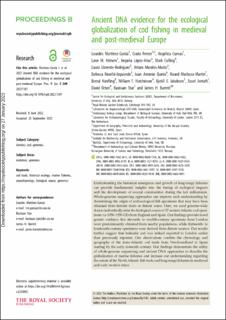| dc.contributor.author | Martinez Garcia, Lourdes | |
| dc.contributor.author | Ferrari, Giada | |
| dc.contributor.author | Cuevas, Angelica | |
| dc.contributor.author | Atmore, Lane Margaret | |
| dc.contributor.author | López-Arias, Begoña | |
| dc.contributor.author | Culling, Mark | |
| dc.contributor.author | Llorente-Rodríguez, Laura | |
| dc.contributor.author | Morales-Muñiz, Arturo | |
| dc.contributor.author | Roselló-Izquierdo, Eufrasia | |
| dc.contributor.author | Quirós, Juan Antonio | |
| dc.contributor.author | Marlasca-Martín, Ricard | |
| dc.contributor.author | Hänfling, Bernd | |
| dc.contributor.author | Hutchinson, William F. | |
| dc.contributor.author | Jakobsen, Kjetill Sigurd | |
| dc.contributor.author | Jentoft, Sissel | |
| dc.contributor.author | Orton, David | |
| dc.contributor.author | Star, Bastiaan | |
| dc.contributor.author | Barrett, James | |
| dc.date.accessioned | 2023-01-30T12:55:21Z | |
| dc.date.available | 2023-01-30T12:55:21Z | |
| dc.date.created | 2022-11-04T13:17:34Z | |
| dc.date.issued | 2022 | |
| dc.identifier.citation | Proceedings of the Royal Society of London. Biological Sciences. 2022, 289 (1985), . | en_US |
| dc.identifier.issn | 0962-8452 | |
| dc.identifier.uri | https://hdl.handle.net/11250/3047128 | |
| dc.description.abstract | Understanding the historical emergence and growth of long-range fisheries can provide fundamental insights into the timing of ecological impacts and the development of coastal communities during the last millennium. Whole-genome sequencing approaches can improve such understanding by determining the origin of archaeological fish specimens that may have been obtained from historic trade or distant water. Here, we used genome-wide data to individually infer the biological source of 37 ancient Atlantic cod specimens (ca 1050–1950 CE) from England and Spain. Our findings provide novel genetic evidence that eleventh- to twelfth-century specimens from London were predominantly obtained from nearby populations, while thirteenth- to fourteenth-century specimens were derived from distant sources. Our results further suggest that Icelandic cod was indeed exported to London earlier than previously reported. Our observations confirm the chronology and geography of the trans-Atlantic cod trade from Newfoundland to Spain starting by the early sixteenth century. Our findings demonstrate the utility of whole-genome sequencing and ancient DNA approaches to describe the globalization of marine fisheries and increase our understanding regarding the extent of the North Atlantic fish trade and long-range fisheries in medieval and early modern times. | en_US |
| dc.language.iso | eng | en_US |
| dc.publisher | The Royal Society Publishing | en_US |
| dc.rights | Navngivelse 4.0 Internasjonal | * |
| dc.rights.uri | http://creativecommons.org/licenses/by/4.0/deed.no | * |
| dc.title | Ancient DNA evidence for the ecological globalization of cod fishing in medieval and post-medieval Europe | en_US |
| dc.title.alternative | Ancient DNA evidence for the ecological globalization of cod fishing in medieval and post-medieval Europe | en_US |
| dc.type | Peer reviewed | en_US |
| dc.type | Journal article | en_US |
| dc.description.version | publishedVersion | en_US |
| dc.source.pagenumber | 9 | en_US |
| dc.source.volume | 289 | en_US |
| dc.source.journal | Proceedings of the Royal Society of London. Biological Sciences | en_US |
| dc.source.issue | 1985 | en_US |
| dc.identifier.doi | 10.1098/rspb.2022.1107 | |
| dc.identifier.cristin | 2069227 | |
| dc.relation.project | Norges forskningsråd: 262777 | en_US |
| dc.relation.project | EC/H2020/813383 | en_US |
| dc.relation.project | EC/H2020/ASTF 354-2016 | en_US |
| dc.relation.project | EC/H2020/658022 | en_US |
| dc.relation.project | EC/H2020/951649 | en_US |
| cristin.ispublished | true | |
| cristin.fulltext | original | |
| cristin.qualitycode | 2 | |

